Discussion on the mechanism of Xiaoyao Powder in the treatment of irritable bowel syndrome based on network pharmacology
Qing-Lu Wu,Yao Li,Fan Yang*
1College of Traditional Chinese Medicine,Shandong University of Traditional Chinese Medicine,Jinan,China.2National Institute of TCM Constitution and Preventive Medicine,Beijing University of Chinese Medicine,Beijing,China.
Abstract
Objective:To predict the key components and potential targets of Xiaoyao Powder in the treatment of irritable bowel syndrome(IBS)and explore its mechanism of action in the treatment of IBS.
Methods:The active components and related targets of all compounds of Xiaoyao Powder were obtained by systematic Pharmacological Analysis platform of traditional Chinese Medicine(TCMSP).The related genes of IBS were collected by Genecards and TTD.The network model of "Xiaoyao powder-compound-target-IBS" was established by Cytoscape software.STRING and Metascape platforms were used to analyze drug-disease target protein interactions and conduct network construction and module analysis.Gene Ontology(GO)function enrichment and Kyoto Encyclopedia of genes and genomes(KEGG)pathway enrichment analysis were performed on the targets.
Results:In the end,149 active ingredients,267 potential targets were obtained in Xiaoyao Powder and 1751 IBS-related targets were obtained from the platforms.One hundred and sixty-five related targets were involved in the treatment of IBS by Xiaoyao Powder,among which the key targets were MMP9,VEGFA,EGF,and IL-1B,TNF,IL-6.In the GO function enrichment analysis,1976 entries were obtained for biological processes,210 entries for molecular functions,and 122 entries for cellular components;KEGG pathway enrichment analysis was performed to obtain PI3K-Akt pathway,AGE-RAGE signaling pathway,Calcium signaling pathway.
Conclusion:Xiaoyao Powder may treat IBS by strengthening intestinal barrier function,reducing visceral sensitivity,inhibiting oxidative stress and inflammation.
Keywords:Network pharmacology,Irritable bowel syndrome,Xiaoyao Powder
Introduction
Irritable bowel syndrome (IBS) is one of the most common gastrointestinal disorders.Studies showed that IBS affects about 5 to 10 percent of the general population worldwide[1].According to the Rome IV criteria,IBS is classified as irritable bowel syndrome with diarrhea(IBS-D),irritable bowel syndrome with constipation(IBS-C),irritable bowel syndrome with mixed bowel habits(IBS-M),and irritable bowel syndrome unclassified (IBS-U)[2].With the development of society,people's lifestyles and dietary habits have changed,and the incidence of IBS is rising.IBS patients often present with a wide range of gastrointestinal symptoms:abdominal pain(usually crampy in nature),abdominal distention,diarrhea,straining,and constipation[2].Except for the physiological effects on the body,patients with IBS have a three-fold increased odds of either anxiety or depression than healthy controls[3-5].
Currently,many methods have been used to treat IBS[6].But the traditional drug therapy,such as antispasmodic,antidepressant,5-hydroxytryptamine 3 receptor antagonist and probiotics,cannot achieve satisfactory clinical efficacy[7].When it comes to herbal treatments,only STW5(Iberogast),peppermint oil and traditional Chinese medicine have shown promise in clinical trials[7,8].Studies have shown that traditional Chinese medicine has unique advantages in treating IBS[9].
Xiaoyao Powder is a very effective prescription for the treatment of IBS in traditional Chinese medicine[10]and is the second most widely used classical prescription in relieving IBS-D symptoms[9].Xiaoyao Powder comprises eight botanical drugs:bupleurum,radix paeoniae alba,angelica sinensis,bighead atractylodes rhizome,poria cocos,mint,ginger and roasted licorice.Bupleurum could be able to soothe the liver and relieve depression.Radix paeoniae alba has obvious actions of nourishing blood and gathering Yin.Angelica sinensis can replenish blood and promote blood circulation.Bighead atractylodes rhizome and poria cocos can strengthen the spleen and diuresis.Ginger’s nature is warm.Mint is very good for dispersing wind and heat.Licorice can tonify spleen and replenish Qi.Xiaoyao Powder has the functions of soothing the liver and relieving depression,invigorating the spleen and nourishing blood.Xiaoyao Powder can be applied to abdominal pain,abdominal distention,diarrhea or constipation[11].The study showed that Xiaoyao Powder is superior to conventional western medicine in the treatment of IBS with fewer adverse reactions[12].However,atpresent,the mechanism of Xiaoyao Powder in the treatment of IBS is not very clear,and there is a lack of related research.
Network pharmacology is a technique used to systematically evaluate the pharmacological effects of drugs with multiple components and multiple targets by establishing links between targets,drugs,and diseases based on the principles of systems biology[13].It was first proposed in October 2007 by Professor Andrew L.Hopkins,a pharmacologist from Dundee University in the United Kingdom.In recent years,it has become a popular tool for the study of the pharmacological basis and mechanism of action of traditional Chinese medicine.It is a suitable method for modern traditional Chinese medicine research [14,15].This study uses network pharmacology to predict the effective compounds,potential targets and signaling pathways of Xiaoyao Powder in the treatment of IBS,and provide a reference for further exploration of the mechanism of Xiaoyao Powder in the treatment of IBS.
Materials and methods
Collection and screening of active components and targets of Xiaoyao Powder
All compounds of Xiaoyao Powder and their corresponding absorption,distribution,metabolism,and excretion(ADME)
parameters were obtained from TCMSP database(http://www.tcmsp-e.com/)[16].The screening conditions of drug active ingredients include oral bioavailability(OB)≥ 30%;drug-likeness(DL)≥0.18.After removing duplicate genes of all drugs,the final targets were entered into the Uniprot database[17](http://www.uniprot.org/)with the organism defined as “human”(verified).
Target acquisition of IBS
Disease genes were obtained using GeneCards [18](http://www.genecards.org/),TTD[19](http://db.idrblab.net/ttd/),DrugBank [20] (http://go.drugbank.com/), DisGeNET [21](http://www.disgenet.org/)database by searching "irritable bowel syndrome".After removing duplicate genes of disease,IBS-related target gene set were import into Uniprot database and standardized the target name.
Draw the network diagram of “traditional Chinese medicine-active ingredients-targets”
Venn tool in the Sangerbox biomedical data analysis platform(http://Sangerbox.com/)was used to draw a "drug target-disease target" Venn diagram.Use Cytoscape 3.9.1 software to draw the network diagram of "traditional Chinese medicine-active ingredients-target",use the built-in tool “Network Analyzer” to analyze the topological parameters of the network,and draw according to the degree of node connection.
Construction of the protein-protein interaction(PPI)network of Xiaoyao Powder in the treatment of IBS targets
In order to explore the interaction between the targets corresponding to the active ingredients in Xiaoyao Powder and the IBS targets,the intersection targets were imported into the STRING database(http://string-db.org/),and the species was set to "Homo Sapiens".We Constructed the PPI network,hided the free target,set the protein interaction score to 0.7,downloaded the TSV format file and imported it into Cytoscape 3.9.1 software.The network analyzer is used to analyze the topology parameters of the network,and the node connection degree,between centrality and closeness centrality are used to screen the core targets.
Enrichment analysis of GO function and KEGG signal Pathway
The target genes of Xiaoyao Powder for the treatment of IBS were uploaded to Metascape database [22](http://metascape.ord/gp/index.html).All species were set as "Homo Sapiens",and "Custom Analysis" was selected for GO function analysis and KEGG signal pathway enrichment analysis respectively.GO functional enrichment analysis includes biological processes(BP),cellular components(CC)and molecular functions(MF).SetMin overlapas 3,P value cutoffas 0.01,andMin enrichmentas 1.5.After data analysis,the top 20 go functions and KEGG channels are selected and uploaded to Sangerbox platform to draw bubble chart and column chart,visualize the data.Cytoscape 3.9.1 software was used to draw the diagram of "traditional Chinese medicine-active ingredienttarget-disease-signal pathway".
Result
Active components and targets of Xiaoyao Powder
The TCMSP database was searched with OB≥30% and DL≥0.18 as the standard,and 161 active components were screened,including 17 Bupleurum,2 Angelica sinensis,13 Radix Paeoniae Alba,7 Bighead atractylodes rhizome,15 Poria cocos,10 Mint,5 Ginger and 92 licorice.Among them,there are 7 active ingredients in common.After deleting the duplicates in the active ingredients and the active ingredients for which the official symbol cannot be found in the Uniprot database,149 active ingredients are finally obtained,and 7 common active ingredients are selected for display(Table 1).The target corresponding to the active ingredient was searched in the TCMSP database,and the total number of targets was 267 after deleting the duplicate target.

Table1 Information of common active ingredients in Xiaoyao Powder
Collection of IBS-related targets and screening and utilization of therapeutic targets of Xiaoyao Powder
By searching GeneCards,TTD,DrugBank and DisGeNET databases,1751 IBS-related targets were obtained after removing duplicate targets from each database.The target of drug active ingredient was mapped into the target of IBS,and finally 165 potential targets of Xiaoyao Powder in the treatment of IBS were obtained.The intersection process of the two groups of data was visualized by online Venn diagram(Figure 1).
Analysis of the network diagram of "traditional Chinese medicine-active ingredient-target"
Cytoscape 3.9.1 software was used to draw the network diagram of "traditional Chinese medicine-active ingredients-target" with 165 intersection targets.The network has 1844 edges and 285 nodes,including 8 herbal nodes,113 compound nodes and 164 target nodes(Figure 2).Calculate the topology parameters in the network through the network analyzer,and screen the nodes with the large node connection degree,between centrality and closeness centrality.These nodes play a pivotal role in the whole network and may be key compounds or targets[23].The top 10 components of node connection degree are quercetin,kaempferol,beta sitosterol,stigmasterol,naringenin,luteolin,isorhamnetin,7-methoxy-2-methyl,isoflavone,medicarpin and formononetin.Luteolin is a single component of bupleurum; isorhamnetin, 7-methoxy-2-methyl,isoflavone,medicarpin and formononetin are single components of licorice,while the other components are common components.These key ingredients are corresponded to Bupleurum,licorice,radix paeoniae alba,mint,ginger,and angelica sinensis.It can be seen that among the eight traditional Chinese medicines that make up Xiaoyao Powder,six traditional Chinese medicines play a relatively more important role.There is a direct relationship between the node area and its degree value in the "medicine-active ingredient-target" network graph.It can be seen from the figure that the target gene degree of PTGS2,ESR1,HSP90AA1,AR,PPARG,NOS2,PRSS1,and PTGS1 are relatively large.
Construction and analysis of potential target interaction network of Xiaoyao Powder in the treatment of IBS
The TSV file was downloaded and imported into Cytoscape 3.9.1 for visualization and analysis.PPI network was built(Figure 3A).The network includes 157 nodes and 1246 edges.Through Network Analyzer analysis,the average value of closeness centrality is about 0.379,the average value of node connectivity degree is about 15.873,and the average value of betweenness centrality is about 0.016;through Centiscape 2.2 analysis,the closeness centrality threshold is about 0.002,the node connectivity degree threshold is about 15.873,and the betweenness centrality threshold is about 277.631.Screening on the condition that the closeness centrality value,node connectivity degree value and betweenness centrality value are greater than the threshold,the key target network is obtained(Figure 3B).The node area and color depth in the figure are related to the connectivity degree value.The larger the node area and the darker the color is,the more important the node is in the network.According to the PPI network diagram of all targets,the top 10 core targets are JUN,TP53,STAT3,AKT1,TNF,IL-6,HSP90AA1,MAPK3,EGFR and RELA.
Enrichment analysis of GO function and KEGG signal Pathway
The potential targets of Xiaoyao Powder in the treatment of IBS were imported into Metascape database for GO function and KEGG signal pathway enrichment analysis.The difference was considered statistically significant when P less than 0.01.In the GO functional enrichment analysis,BP analysis obtained 1976 items.The first three items were “cellular response to nitrogen compound”, “response to inorganic substance”, “response to xenobiotic stimulus”.CC analysis obtained 122 items;the first three items were “membrane raft”,“postsynaptic membrane”,“receptor complex”.MF analysis obtained 210 items;the first three items were“protein homodimerization activity”,“postsynaptic neurotransmitter receptor activity”,“cytokine receptor binding”.Select the most significant twenty processes in BP,CC,and MF to draw GO functional analysis map(Figure 4).A total of 200 signal pathways were obtained by KEGG signal pathway enrichment analysis,and the twenty most significant processes were selected to draw KEGG signal pathway enrichment analysis(Figure 5).Cytoscape 3.9.1 was used to draw the " drug-active ingredients-target-IBS-signaling pathway" diagram(Figure 6).
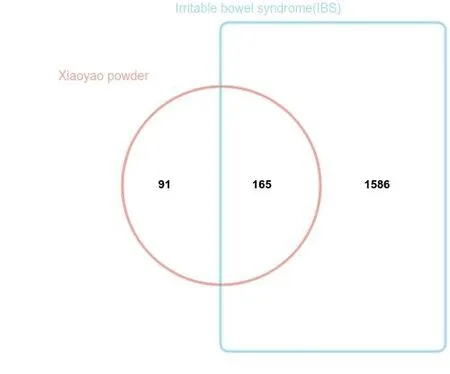
Figure 1 Venn diagram of drug-IBS intersected targets
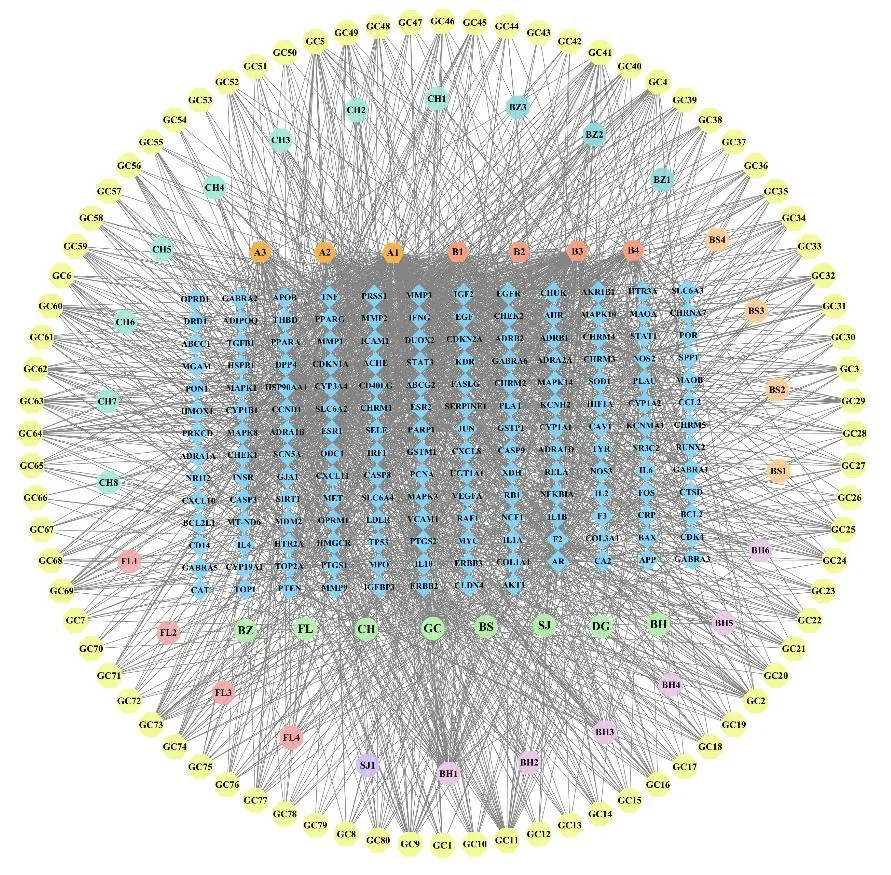
Figure 2 Network diagram of "medicinal material-active ingredient-target"
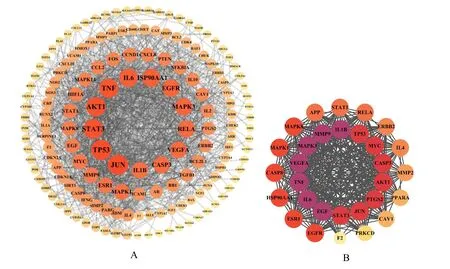
Figure 3 PPI network of potential targets of Xiaoyao Powder in treatment of IBS

Figure 4 Enrichment analysis of potential targets of Xiaoyao Powder in treatment of IBS

Figure 5 Enrichment analysis of KEGG signal pathway of potential target of Xiaoyao Powder in treatment of IBS
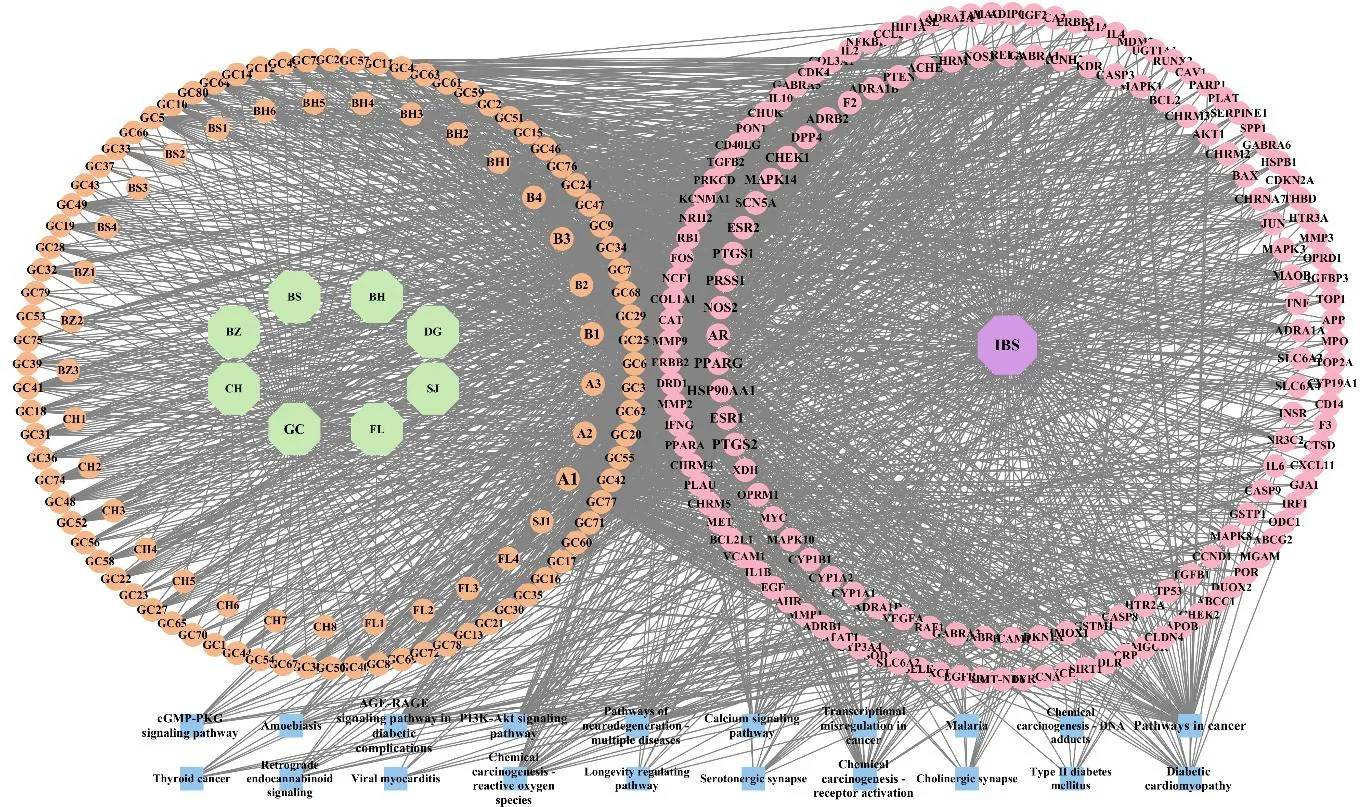
Figure 6 Network of drug-active ingredients-target-IBS-signaling pathway
Discussion
According to the "traditional Chinese medicine-active ingredients-target " network map,the main active ingredients in Xiaoyao Powder are quercetin, kaempferol, beta-sitosterol,stigmasterol,naringenin.Quercetin is a kind of natural flavonoids which can be widely obtained in nature.It has multiple biological activities,such as antioxidation,analgesia,anticancer[24,25].Nuclear factor E2 related factor 2(Nrf2)is a key regulator of antioxidant response[26],as many of its downstream target genes are involved in preventing or correcting redox imbalances in the cell.Quercetin regulates intracellular redox status by scavenging reactive oxygen species(ROS),enhancing intracellular glutathione content,regulating tight junctions and enhancing the abundance of anti-apoptotic proteins in an Nrf2-dependent manner.That is,it has a protective effect on cell death and intestinal barrier dysfunction induced by quaternary ammonium salt through Nrf2 signal transduction in intestinal cells[27].5-HT is an important signal molecule targeting intestinal cells,smooth muscle and neurons in the gut.It is related to the regulation or control of several symptoms of IBS7.Studies have shown that quercetin can reduce visceral hypersensitivity in PI-IBS rat model by reducing the utilization rate of 5-HT,thus playing an analgesic effect[28].Kaempferol belongs to the subclass of flavonols and is widely distributed in many vegetables,fruits and legumes. Kaempferol significantly attenuated diquine-induced cell death and mitochondrial depolarization,reduced oxidative damage,and partially reversed the decrease of mRNA levels of CyclinD1,CDK4,CDK6,CyclinA,CDK2 and E2F1 (CDK:cyclin-dependent kinase),thus regulating cell proliferation[29].Both quercetin and kaempferol have regulatory effects on Nrf2,and both can inhibit the spontaneous contraction of the longitudinal muscle of the colon in rats by regulating Ca2+channels to achieve spasmolytic effect[30].Beta-Sitosterol is a phytosterol,which is the main component of plant cell membranes and has biological effects such as analgesia, antibacterial, and anti-inflammatory [31]. It can significantly increases the activities of antioxidant enzymes such as superoxide dismutase,glutathione,and catalase,and reduces tumor necrosis factor(TNF-α),interleukin-1β (IL-1β)and interleukin-6(IL-6)level[32],and inhibits LPS/Gal N-induced overexpression of Toll-like receptor 4 and nuclear factor kappa B(NF-κB)[33].Stigmasterol,which belongs to the same phytosterol,has similar effects as β-sitosterol.It reduces inflammation by inhibiting NF- κB signal pathway including the expression of inflammatory cytokines TNF- α,IL-6,IL-1 β,CSF-1 and coenzyme COX-2[34].Naringenin is an active compound of flavonoids.It can exert its antioxidant effect by reducing free radicals such as ROS and increasing the activity of antioxidant enzymes[35].And it can significantly alleviate the destruction of intestinal vascular barrier induced by TNF-α by maintaining the tight junction protein model and inhibiting NF-κB-mediated MLCK/p-MLC and NLRP3 pathways[36].Among the top ten active ingredients,licorice contains seven;bupleurum contains four;and Radix Paeoniae Alba,mint,ginger and angelica sinensis all contain two.It is speculated that licorice and bupleurum may be the core of Xiaoyao Powder in the treatment of IBS,especially licorice.
Through the PPI network diagram,the key targets of Xiaoyao Powder in treating IBS are MMP9,VEGFA,EGF,IL-1B,TNF,IL-6.Matrix metalloprotein 9(MMP9)is a zinc-dependent endopeptidase that counteracts an extracellular matrix protein expressed in the gastrointestinal tract during inflammation that limits the accumulation of reactive oxygen species in the intestine[37].Vascular endothelial growth factor A(VEGFA)is a member of the vascular endothelial growth factor(VEGF)family,which is more common in the treatment of angiogenesis-dependent diseases such as cancer.At present,single nucleotide polymorphisms and VEGFA plasma levels of VEGFA linkage variants(rs699947 and rs833061)are associated with the risk of necrotizing enterocolitis in premature infants[38].However,some studies have shown that there is no statistically significant difference in serum VEGF and endostatin levels between IBS patients and healthy controls[39].Therefore,whether VEGFA is related to the occurrence of IBS remains to be further studied.Epidermal growth factor(EGF)is an important cell growth factor in human endocrine.The decrease of its level may help to form visceral hypersensitivity by down regulating the uptake of 5-HT mediated by serotonin transporter(SERT)into intestinal cells,and visceral hypersensitivity is the most likely culprit of sensory abnormalities in patients with IBS[40].With regard to IL-1B,TNF and IL-6,the results showed that the level of TNF-α in IBS patients was significantly higher than that in healthy controls,and there was a positive correlation between TNF-α and the fatigue effect of IBS patients on daily life[41];The level of circulating IL-6 in patients with IBS was higher than that in the control group[42];IL-1β may be involved in the pathogenesis of IBS by regulating colonic function[43].
KEGG pathway enrichment analysis found that PI3K-Akt signaling pathway,AGE-RAGE signaling pathway,calcium signaling pathway are the main therapeutic pathways.PI3K-Akt signal pathway is an intracellular signal transduction pathway,which is related to proliferation,differentiation and apoptosis;Inhibiting PI3K-Akt signal pathway can reduce visceral sensitivity[44].Studies have shown that PI3K-Akt signaling pathway plays a pro-inflammatory role in intestinal diseases such as colitis[45],and can regulate intestinal mucosal barrier function to a certain extent[46].The study showed that Tongxieyaofang,including bighead atractylodes rhizome and radix paeoniae alba,may reduce visceral sensitivity and treat IBS-D by inhibiting PI3K-Akt signal pathway,reducing autophagy,protecting intestinal epithelial cells and restoring intestinal mucosal barrier[47].In the AGE-RAGE signaling pathway,receptors for AGEs(RAGE)are widely expressed throughout the gastrointestinal tract and are regulators of intestinal barrier integrity[48],while intestinal barrier dysfunction is considered to be a major problem in IBS[49].Pathologically,AGEs-mediated accumulation of RAGE triggers oxidative stress and inflammation,which are the major deleterious effects of AGEs in the gut microenvironment[50].Calcium ion is an important signal molecule in cells.Calcium signaling in endothelial cells is a key regulatory mechanism for barrier function and inflammation[51].It has been proved that amino acids can reduce intestinal inflammation through calcium-sensitive receptors[52].Otilonium bromide,a smooth muscle relaxant used to treat IBS,has been shown to interfere with the mobilization of calcium in intestinal smooth muscle[53-56].Studies have shown that Otilonium bromide inhibits the production of calcium signal in human colon crypt induced by acetylcholine,but can not inhibit calcium signal induced by other endogenous receptors,so the researchers believe that the calcium signal pathway coupled by M3 receptor is the direct target of Otilonium bromide at colonic epithelial level,suggesting its antisecretory therapeutic value in patients with diarrheal IBS[57].In addition,calcium signaling pathway is also involved in the regulation of intestinal microorganisms[58].Calcium signal transduction of interstitial cells plays an important role in gastrointestinal inflammation[59].
Conclusion
This study used network pharmacology to explore the mechanism of Xiaoyao powder in the treatment of IBS,and verified the process of multi-pathway,multi-target and coordinated treatment of diseases with traditional Chinese medicine compound prescription.Xiaoyao Powder may interact with MMP9,VEGFA,EGF,IL-1B,TNF,IL-6 through active components such as quercetin, kaempferol,beta-sitosterol,stigmasterol and naringin,thus regulating PI3K-Akt,AGE-RAGE,calcium signal pathways,thereby enhancing intestinal barrier function,reducing visceral sensitivity,inhibiting oxidative stress,inhibiting inflammation,and achieving the purpose of treating IBS.
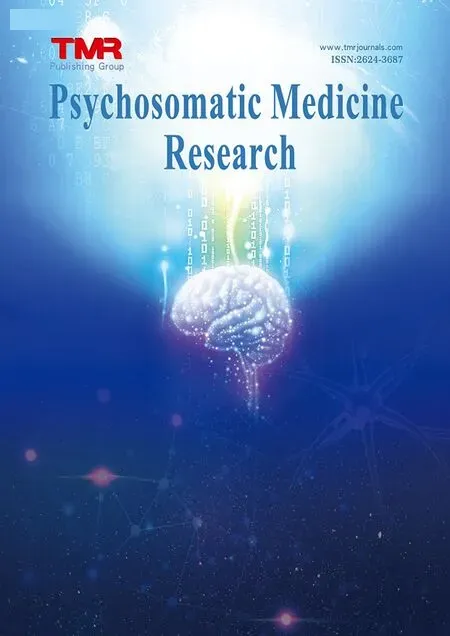 Psychosomatic Medicine Resesrch2022年2期
Psychosomatic Medicine Resesrch2022年2期
- Psychosomatic Medicine Resesrch的其它文章
- Psychological Impact of Chronic Kidney Disease and Hemodialysis:Narrative Review
- Health behaviours and wellbeing of health workers amidst the COVID-19 pandemic
- The relationship between physical exercise and subjective well-being in Chinese college students:the mediating role of psychological resilience and the moderating role of peer influence
- Survey and analysis of the current situation of humanistic care ability of first-year nursing students after COVID-19
- Electronic Cigarette Use Scale:Development and evaluation of a measure among Chinese students
